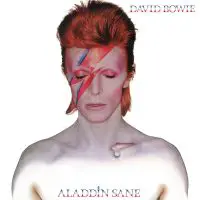 Recorded: October 1972 – January 1973
Recorded: October 1972 – January 1973
Producers: David Bowie, Ken Scott
Engineers: Ken Scott, Mike Moran
Released: 19 April 1973
Personnel
David Bowie: vocals, guitar, harmonica, saxophone, Moog synthesizer
Mick Ronson: guitar, piano, vocalstr
Mike Garson: piano
Trevor Bolder: bass guitar
Mick ‘Woody’ Woodmansey: drums
Ken Fordham: saxophone, flute
Brian ‘Bux’ Wilshaw: tenor saxophone, flute
Juanita ‘Honey’ Franklin, Linda Lewis: backing vocals
Geoff MacCormack: backing vocals, percussion
Aynsley Dunbar: percussion
Tracklisting
Contents
- ‘Watch That Man’
- ‘Aladdin Sane (1913-1938-197?)’
- ‘Drive-In Saturday’
- ‘Panic In Detroit’
- ‘Cracked Actor’
- ‘Time’
- ‘The Prettiest Star’
- ‘Let’s Spend The Night Together’
- ‘The Jean Genie’
- ‘Lady Grinning Soul’
The follow-up to the hugely successful Ziggy Stardust album, Aladdin Sane found David Bowie experimenting with a range of new musical styles, and reflected his experiences while touring in America and Europe.
It was almost like a treading-water album, but funnily enough, in retrospect, for me, it’s the more successful album, because it’s more informed about rock ‘n’ roll than Ziggy was.
Aladdin Sane was Bowie’s first album written after his ascent to superstardom. The lyrics often reflected his rootless existence during the lengthy Ziggy Stardust Tour, with the cities and countryside of America a key influence.
In 1976, while making the Station To Station album, Bowie spoke to Rolling Stone about his efforts to construct a rock star image.
At the time I did Aladdin Sane, all I had was a small cult audience in England from Hunky Dory. I think it was out of curiosity that I began wondering what it would be like to be a rock & roll star. So basically, I wrote a script and played it out as Ziggy Stardust onstage and on record. I mean it when I say I didn’t like all those albums — Aladdin Sane, Pin Ups, Diamond Dogs, David Live. It wasn’t a matter of liking them, it was ‘Did they work or not?’ Yes, they worked. They kept the trip going.
Rolling Stone, 12 February 1976
David Bowie considered several titles for the album. Rejected ideas included A Lad Insane, Love Aladdin Vein, and simply Vein. For a brief period the song ‘Time’ was also considered as a title track.
Originally, I felt Love Aladdin Vein was right, then I thought, ‘Maybe I shouldn’t write them off so easily’ – so I changed it. Also Vein – there was the drugs thing, but it’s not that universal.
Disc & Music Echo
Aladdin Sane was unveiled on 27 January 1973 in an NME interview headlined “Goodbye Ziggy and a Big Hello to Aladdin Sane.
A person called Aladdin Sane, Aladdin is really just a track. The album was written in America. The numbers were not supposed to form a concept album, but looking back on them, there seems to be definite linkage from number to number. There’s no order; they were written in different cities, and there’s a general feeling on the album which at the moment I can’t put my finger on. It’s a feeling I’ve never yet produced on an album; I think it’s the most interesting album that I’ve written, musically as interesting as any of the things I’ve written…I don’t think Aladdin is as clearly cut and defined a character as Ziggy was. Ziggy was meant to be clearly cut and well defined with areas for interplay, whereas Aladdin is pretty ephemeral. He’s also a situation as opposed to just being an individual. I think he encompasses situations as well as just being a personality.
NME, 27 January 1973

This site is awesome. Thoroughly enjoying TheBowieBible. Bravo for collecting all the minute details for each album… many that even a Bowie fanatic like me didn’t know.